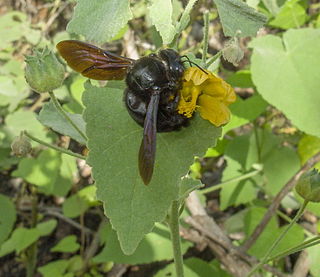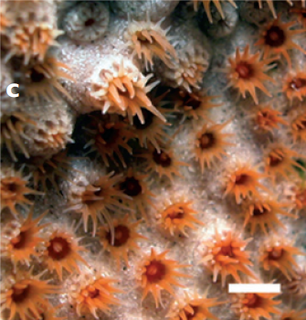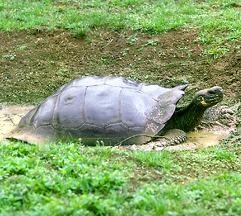Nesoryzomys darwini, also known as Darwin's nesoryzomys or Darwin's Galápagos mouse, is a species of rodent in the genus Nesoryzomys that lived on Santa Cruz Island in the Galápagos Islands. It was probably nocturnal and inhabited burrows or rock crevices under bushes. Only four specimens exist, collected by Frank Wonder between 12 and 16 January 1929. This extinction may have been caused by competition and disease created by the introduction of nonnative brown and black rats.

The Galápagos tortoise or Galápagos giant tortoise is a species of very large tortoise in the genus Chelonoidis. It comprises 15 subspecies. It is the largest living species of tortoise, with some modern Galápagos tortoises weighing up to 417 kg (919 lb). With lifespans in the wild of over 100 years, it is one of the longest-lived vertebrates. Captive Galapagos tortoises can live up to 177 years. For example, a captive individual, Harriet, lived for at least 175 years. Spanish explorers, who discovered the islands in the 16th century, named them after the Spanish galápago, meaning "tortoise".
Calosima is a gelechoid moth genus of the family Blastobasidae.

The red-lipped batfish or Galapagos batfish is a fish of unusual morphology found around the Galapagos Islands and off Peru at depths of 3 to 76 m. Red-lipped batfish are closely related to rosy-lipped batfish, which are found near Cocos Island off the Pacific coast of Costa Rica. This fish is mainly known for its bright red lips. Batfish are not good swimmers; they use their highly adapted pectoral, pelvic and anal fins to "walk" on the ocean floor. When the batfish reaches maturity, its dorsal fin becomes a single spine-like projection.
Darwini, a New Latin adjective that commonly refers to Charles Darwin, may refer to:
Dialectica sanctaecrucis is a moth of the family Gracillariidae. It is known from Cuba, the Dominican Republic, Jamaica, Puerto Rico, the Virgin Islands and the Galápagos Islands.
Coleophora darwini is a moth of the family Coleophoridae. It is found on the Galápagos archipelago where it has been collected on Pinzón, Española, and Pinta islands.

Pseudalsophis is a genus of snakes in the family Colubridae. The genus is endemic to South America.
Periploca darwini is a moth in the family Cosmopterigidae. It was described by Bernard Landry in 2001. It is found on the Galápagos Islands.
Trapania darwini is a species of sea slug, a dorid nudibranch, a marine gastropod mollusc in the family Goniodorididae.

Xylocopa darwini, the Galápagos carpenter bee, is the only native species of bee in the Galápagos Islands, to which it is endemic. Altogether, only three species of bee are found in the islands. This species found on 75% of the largest islands. It is sexually dimorphic and is known for its complex behavior. As the only native bee, Xylocopa darwini serves as an important primary pollinator within the plant-pollinator network of the archipelago.
Galagete darwini is a moth in the family Autostichidae. It was described by Bernard Landry in 2002. It is found on the Galápagos Islands.

Parazoanthus darwini is a species of macrocnemic zoanthid first found in the Galapagos. It can be distinguished by its association with sponges, by having about 24–30 tentacles and polyps embedded in a well-developed coenenchyme.

The Volcán Wolf giant tortoise, also known commonly as the Wolf Volcano giant tortoise and the Cape Berkeley giant tortoise, is a subspecies of Galápagos tortoise in the family Testudinidae. The subspecies is native to the north side of Ecuador's Isabela Island. Chelonoidis becki has links to two different lineages including that of Chelonoidis darwini from the nearby island of Santiago. C. becki has been found to be the product of a double colonization event beginning around 199,000 years ago, and had been formed through introgression, where greater male selectivity was exhibited by purebred females in one of the lineages. It is most commonly found on the northern, western, and southwestern slopes of Volcán Wolf, the volcano that it is named for. Having evolved to live in a specific environment, C. becki only occupies an estimated range of about 263 square kilometers. An estimated 1,150 Volcán Wolf giant tortoises inhabit Volcán Wolf.

Semicossyphus darwini is a species of ray-finned fish native to the tropical eastern Pacific Ocean. Common names include the Chilean sheepshead wrasse, the goldspot sheepshead or the Galapagos sheepshead wrasse.
Darwin's leaf-toed gecko is a species of lizard in the family Phyllodactylidae. The species is endemic to San Cristóbal Island in the Galapagos.

The Santiago Island giant tortoise, also known commonly as the Santiago giant tortoise and the James Island tortoise, is a subspecies of Galápagos tortoise in the family Testudinidae. The subspecies is endemic to Santiago Island in the Galápagos.







